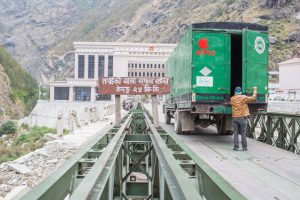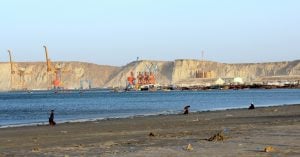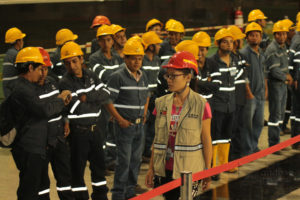Located just three kilometres from the Hindu shrine of Badrinath, Mana is the last village near the India-China border. At a height of more than 3,000 metres and known for its condiments, handicrafts and herbal tea, the village is a special attraction for pilgrims and tourists alike.
It is also the gateway to an arduous walk to two important Himalayan glaciers — Satopanth and Bhagirath-Kharak. With enthusiastic trekkers trickling in, Mana remains abuzz between May and October every year. But these two glaciers are retreating, slowly and continuously.
Satopanth and Bhagirath-Kharak are among the most monitored and analysed glaciers in the Himalayas. Their snouts are separated by just 1.5 kilometres and there is little difference in their altitudes; Satopanth is situated at 3,870 metres above sea level and Bhagirath-Kharak at 3,796 metres.
Satopanth is the origin of the Alaknanda river, and Bhagirath-Kharak is the source of a stream called the Uttar Ganga. Both watercourses merge after covering a short distance and become one of the largest tributaries of the Ganga.

These two mid-sized glaciers are termed benchmark glaciers; their length and size make them ideal for scientific study. They are also easily accessible, making it possible for researchers to conduct ground experiments. Interestingly, India’s famous Gangotri glacier isn’t a preferred glacier for field studies as it is too long at 30 kilometres, whereas Satopanth and Bhagirath-Kharak are just 13 and 18.5 kilometres long.
“The size is crucial. Gangotri glacier, being too large, isn’t feasible for study and analysis because you can’t access it more than 3-4 km,” Harish Chandra Nainwal, Head of the Geology Department in Hemvati Nandan Bahuguna Garhwal University in Uttarakhand, told indiaclimatedialogue.net. “However, the situation is different at the Satopanth and Bhagirath-Kharak glaciers. They are average in size and length and much of the glaciers is accessible, which is an ideal scenario for any researcher.” Nainwal has been researching these two glaciers for more than 10 years.
Due to their inaccessibility, information about glaciers is often gathered by remote sensing technique. There are very few glaciers like Satopanth and Bhagirath-Kharak that are constantly monitored on the ground as well. “The fieldwork and ground validation of the information gathered by satellite is important and it is regularly being done here at Satopanth and Bhagirath-Kharak,” S.P. Sati, a geologist who is working in Himalayas for several years, told indiaclimatedialogue.net. Satopanth glacier is 21 square kilometres in size, whereas the Bhagirath-Kharak is around 31 square kilometres.

“Based on several old records and maps, we have presented evidence that while the glacier front of Satopanth Glacier and Bhagirath-Kharak glacier depicted in the Survey of India’s (1962) topographic maps are inaccurate, the coordinates and elevation are fairly accurate,” it says. “This has led to revised estimates of the area vacated and snout retreat in the last 57 years.”
Initially, the study of glaciers by the Geological Survey of India in the 1960s and 1970s was mainly done through remote sensing, and focused on the position of the snout of a glacier – done annually to ascertain the rate at which a glacier was retreating, or in rare cases, advancing.
“They tried to measure it (by satellite imaging) every year in several glaciers across the Himalayas but soon realised that it wasn’t the perfect way to know the health of a glacier,” said an expert during a recent Satopanth trek. “The measurement of net mass balance of glaciers is a much more reliable method.”
A glacier is divided in two zones — snow and ice deposits are found in the accumulation zone, and the loss of ice due to melting takes place in the ablation zone. Mass balance is the difference between the accumulation and ablation of snow on any glacier. An advancing glacier will have a positive mass balance, and a retreating glacier will have a negative mass balance.
Harish Chandra Nainwal is the head of the geology department at Hemvati Nandan Bahuguna Garhwal University in Uttarakhand. He and his team initiated glaciological studies on the Satopanth glacier in 2013 and found the mass balance to be around two metres less than the water equivalent for 2015. Estimates of the glacier’s mass balance for subsequent years are still being analysed and will be published next year.
Almost all Himalayan glaciers are retreating, including Gangotri, Satopanth and Bhagirath-Kharak. Field research and ground validation has shown that the snouts of the Satopanth and Bhagirath-Kharak glaciers have retreated at a rate of 5.7 and 6.0 metres per year respectively. The Gangotri glacier has been retreating much faster at a rate of 19 metres every year between 1935 and 1999. In recent years, however, the rate of retreat of the Gangotri glacier has slowed down.
Moraine cover
While experts have attributed the retreat of glaciers to the warming climate, they also say that moraine cover helps Himalayan glaciers protect themselves from melting. More than 65% of Satopanth’s total length is covered by moraine (an accumulation of glacial debris), which protects the glacier from melting by minimising the impact of direct sunlight.
Both Satopanth and Bhagirath-Kharak are experiencing a similar warming climate, but a regular avalanche-feed from snow peaks keeps adding to their mass.
“There have been justified concerns for our glaciers,” Nainwal told indiaclimatedialogue.net. “We all know they are melting and retreating. But still, they are not as unhealthy in given climatic conditions as they are shown in the media.”
There are various factors affecting the health of glaciers. In recent years, erratic rain and snowfall patterns have been observed more frequently in the Himalayan region.
“Earlier, rain would not fall after a certain height, but now rain is happening even at the height of the Satopanth and Bhagirath-Kharak glaciers,” Aditya Mishra, a research scholar, told indiaclimatedialogue.net. “Snowfall has decreased and it often takes place at a season when it is not expected or required.”
Peculiar things are happening at these heights in the Himalayas. At 4,350 metres, the moraine-dammed Satopanth Taal (lake) has shrunk significantly in the last few years. On the other hand, many new small lakes are forming at the top of glaciers. There are many reasons for this, but all are due to the faster melting of Himalayan glaciers.
This article first appeared on indiaclimatedialogue.net
![<p>The snout of the Bhagirath-Kharak glacier [image by: Hridayesh Joshi]</p>](https://dialogue.earth/content/uploads/2017/12/glacier.jpg)






